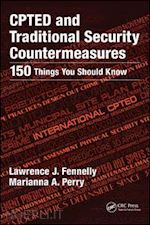Lawrence J. Fennelly is an internationally recognized authority on crime prevention, security planning and analysis, and on the study of how environmental factors (CPTED), physical hardware, alarms, lighting, site design, management practices, litigation consultants, security policies and procedures, and guard management contribute to criminal victimization. Mr. Fennelly was previously employed with Apollo Security, Computershare, Inc., as well as a sergeant at Harvard College, employed by the Harvard University Police Department in Cambridge, Massachusetts. He was trained as a crime prevention specialist and served in this capacity for over 21 years at Harvard. He was also the department’s training officer and assistant court officer. As part of his role as an officer at Harvard, Larry also was a deputy sheriff in both Suffolk and Middlesex counties (Massachusetts). Mr. Fennelly is a frequent speaker and lecturer on CPTED, physical security, school crime, and other issues. He serves as an expert witness who works closely with attorneys in defense as well as plaintiff cases, assisting in case preparation, offering knowledgeable questions to ask the opposing side, etc. He has also done a considerable amount of consultant work throughout the United States. His experience ranges from identifying vulnerabilities to conducting security and lighting surveys, working with architects to design and implement security, and developing long range guard training programs and risk assessments of various facilities. He is also a prolific author. His titles include such well-known security books as "Crime Prevention Through Environmental Design," "Effective Physical Security," and "Handbook of Loss Prevention and Crime Prevention."Marianna A. Perry is a Certified Protection Professional (CPP) through ASIS International and has 35+ years of progressive experience in law enforcement, physical security, safety and loss control. Marianna received her B.A. Degree from Bellarmine University and her Master’s Degree from Eastern Kentucky University. She is a safety and security consultant and is a frequent presenter at the annual ASIS International Seminar. She is also adjunct faculty at Sullivan University in the Department of Justice and Public Safety Administration. Marianna is a former trooper and detective with the Kentucky State Police and was previously the Director of the National Crime Prevention Institute (NCPI) at the University of Louisville. She is a member of the ASIS International School Safety and Security Council as well as the Women in Security Council. Her recent books (with Larry Fennelly) are titled, The Handbook for School Safety and Security & Security for Colleges and Universities.











